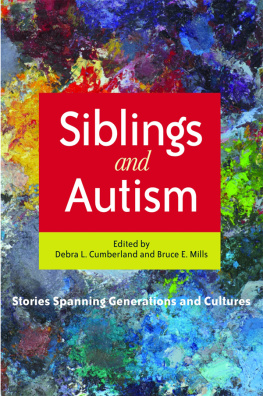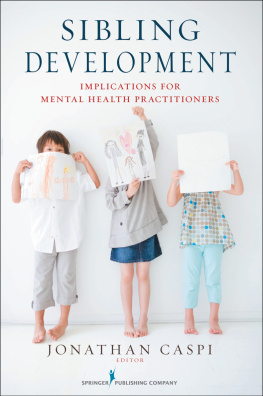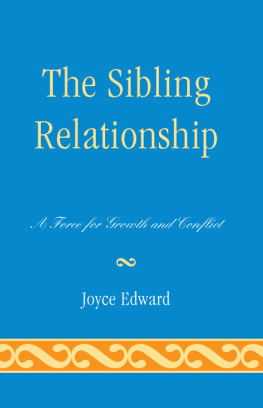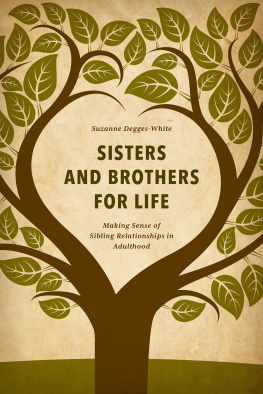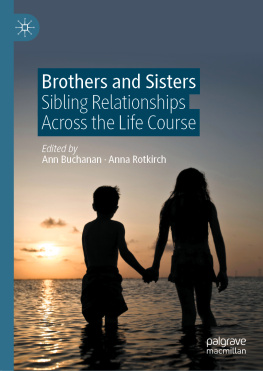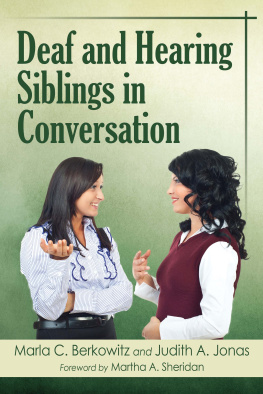The Sibling Connection: How Siblings Shape Our Lives
by
Jane Mersky Leder
Copyright Information
The Sibling Connection, Copyright Jane Mersky Leder, 2015
All rights reserved. No part of this publication may be reproduced, distributed, or transmitted in any form or by any means, including photocopying, recording, or other electronic or mechanical methods, without the prior written permission of the publisher, except in the case of brief quotations embodied in critical reviews and certain other noncommercial uses permitted by copyright law.
...
Distributed by Bublish, Inc.
www.bublish.com
...
Cover design by AM Design Studios
...
Edited by Hannah Eason
...
ISBN-10: 0-9964444-4-0
ISBN-13: 978-0-9964444-4-6
...
This e-Book is licensed to the original purchaser only. Duplication or distribution via any means is illegal and a violation of International Copyright Law, subject to criminal prosecution and upon conviction, fines and/or imprisonment. No part of this ebook can be reproduced or sold by any person or business without the express permission of the publisher.
...
For Robin, John, Liz, Mom, and Dad
Acknowledgments
I am indebted to the handful of researchers who have made the stuff of sibling relationships their lives work, many of whom patiently and expertly answered my questions and encouraged me to carry on. To the many brothers and sisters who trusted me enough to listen to their stories and to retell them, I am deeply grateful. You made me laugh and cry and stand in awe of the power of the sibling connection and how it shapes our lives across the life span. And to my own siblings and all that they have taught me about this special, complicated, and ever-changing connection.
Foreword
Starting with the jolt of her opening sentences, Jane Leder takes us on an eye-opening tour of the rich, confusing, and often painful world of siblings. Because sibling relationships are rarely talked about in any depth, most of us grope for words to describe our emotions; about brothers and sisters we are strangely inarticulate. I have never met a person who would not want to improve a stale or hurtful or confusing relationship with a sibling. This book repeatedly tells you that its never too late to learn about ourselves or to close the gap between our brothers, sisters, and ourselves.
Jane Leder speaks with wisdom gleaned from her own attempts to better her relationships within her family, yet her voice is disciplined and informed by the best available knowledge and speculation of social scientists and clinicians. The result is a rich tapestry, allowing many possibilities for the reader to see his/her own lifes sibling through a clearer lens.
As adults we are continually trying to understand why we are, how we are, and the way we are. Our siblings are important mirrors for identity, and Jane Leder has written in a way that provides such a mirror for anyone who wants to connect with personal experience. In this sense, I hope that this will do for the reader what Gail Sheehys Passages did for our ability to understand ourselves at midlife.
Sibling relationships are lifes longest-lasting family relationships. The sibling bond can be both mysterious and unconscious. The Sibling Connection unveils the mystery and brings to awareness the feelings and forces that can help to make us more human, less ashamed, and more able to take advantage of the possibilities of being a brother or a sister.
Stephen P. Bank, Ph.D., coauthor with Michael Kahn of The Sibling Bond; clinical psychologist and family therapist in Middletown, Connecticut.
Introduction
Full disclosure alert: my younger brother and I dont talk. We havent spoken for four years and counting. How ironic that in my first book about siblings, Brothers&Sisters: How They Shape Our Lives, I wrote a chapter about reconnecting with siblings and offered strategies for mending a frayed relationship and touted the advantages of making amends.
Oops.
At the time, my younger brother and I were still negotiating how, as adults, we might acknowledge our past stuff and find a balance in what had been a complicated connection since childhood. I thought I had the clarity that comes with age to settle old scores and move forward.
I was wrong.
For my brother and me, it was a dispute over my parents inheritance and his ill will toward them that put the proverbial nail in the coffin. As hard as I tried to acknowledge that his experiences with my parents were different from mineas much as I tried to understand his rush to finalize the estate, get his money and runmy anger trumped forgiveness and wisdom.
Our frozen misunderstanding is one reason I decided to revisit the sibling relationship. Another is a question I first explored in Brothers&Sisters. Its difficult to find anyone today who cant rattle off issues with their parentshow their parents raised them, what they did right, what they did wrong, and the effect all this parenting (or lack of it) had on them.
But talking about how brothers and sisters may have shaped our lives is, for many, new and sometimes unsettling territory. Yet we spend more time with our siblings under the same roof than we do with our parents. In 2014, 92.8 percent of all fathers with children under age eighteen and 70.2 percent of mothers worked outside the home. Still, the majority of research has focused on the influence of parents in our lives, while the significance of siblings has been strangely neglected.
When the topic of siblings is raised, the operative response is sibling rivalry. A slew of books have been published on the subject, including Adele Faber and Elaine Mazlishs bestseller, Siblings Without Rivalry. In the authors introduction, they discuss the focus groups they ran and the questionnaires they compiled. They discovered that sibling rivalry was the number-one leading concern of parents. Mothers and fathers were often overwhelmed and at a loss at how to help their children live together so they could live too.
But the sibling relationship is deep and layered. It is potentially lifes longest-lasting family relationship and rarely static. It changes over time. Siblings outlive their parents on average by twenty to thirty years. What may be a contentious, competitive relationship with our siblings in childhood can become a close, important one later in life.
Our siblings can be the only intimate connection that seems to last. Friends and neighbors may move away, former coworkers are often forgotten, marriages end in divorce, but our brothers and sisters remain our brothers and sisters.
As Stephen Bank writes in the foreword of this book, As adults we are continually trying to understand why we are, how we are, and the way we are. Our siblings are important mirrors for identity ... an important mirror for anyone who wants to connect with personal experience.
So, grab your mirror and have a look.
My Sibling Relationships
Brothers and sisters were a mystery to her. There were Grace and Vera, speaking like two mouths out of the same head, and Wilfred and Albert without a thread of connection between them.Alice Munro, Visitors
I was the oldest of four. When my brother took his own life on his thirtieth birthday, I became the oldest of three.
And that changed everything.
My brother had been my best friend in the family. With him gone, I was lost.
The second born of four, my brother was in many ways my thread of connection. When he took his own life, the roles we three surviving siblings had known and accepted were never the same.



